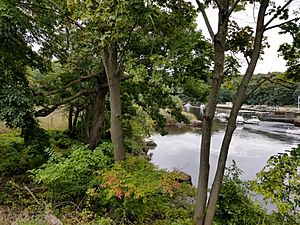Cutshamekin facts for kids
Cutshamekin (died 1654) was an important Native American leader. He was a sachem (which means chief) of the Massachusett tribe. His people lived near the Neponset River and Great Blue Hill in what is now Dorchester and Milton, Massachusetts. Later, he became a leader in Natick, Massachusetts, one of the first "Praying Indian" towns. Some people believe the name "Jamaica Plain" might have come from his name.
Contents
Who Was Cutshamekin?
Cutshamekin was the brother of two other sachems, Chickatawbut and Obtakiest. Sadly, both of his brothers died in 1633 during a smallpox outbreak. This disease greatly affected many Native American groups in the area. After their deaths, Cutshamekin became a key leader for his people.
Land and Treaties
In the 1630s, Cutshamekin sold much of the land his tribe controlled. This land was located around the Neponset River. For example, he sold what is now Milton, Massachusetts to Richard Callicott. However, he kept 40 acres of land for his people. This special area was near the Neponset River and Dorchester Mills. Today, parts of this land are Dorchester Park and the Ventura Playground. These are now part of the Neponset River Reservation.
By selling so much land, Cutshamekin's followers became more separated. In 1643 or 1644, Cutshamekin and four other sachems signed an important treaty. They agreed to work with the Massachusetts Bay Colony and its governor, John Winthrop. In return, the colony promised to help protect them from their enemies.
Working with Missionaries
In 1646, a missionary named John Eliot visited Cutshamekin and his people. Eliot gave his first sermon to them at their wigwam. This was near Israel Stoughton's grist mill and Richard Callicott's trading post. Today, this area is known as Dorchester, Lower Mills.
At first, Cutshamekin and his followers were not very interested in Eliot's message. But Eliot kept meeting with them every two weeks. Over time, he started to have some success.
Joining the Praying Indians
By 1651, Cutshamekin had joined the Praying Indians in Natick, Massachusetts. He became a leader there. The Praying Indians were Native Americans who had adopted some European customs and Christian beliefs.
Cutshamekin passed away in 1654. He was buried on his remaining 40 acres of land in Dorchester. His burial was a special ceremony, fit for a sachem. His wealth of furs was placed on tree branches around his grave. After his death, his nephew, Josias Wampatuck, became the new leader. Cutshamekin had helped raise Josias.
The Name of Jamaica Plain
Some historians believe that the Boston neighborhood "Jamaica Plain" might be named after Cutshamekin. They think "Jamaica" is an Anglicized (English version) way of saying "Kuchamakin." Cutshamekin was a regent (a temporary ruler) for the young Chickatawbut, who was the sachem of the Massachusett tribe.


